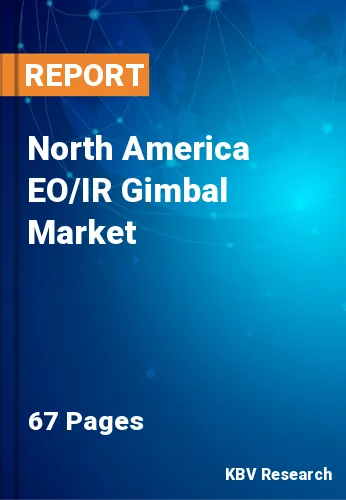The North America EO/IR Gimbal Market would witness market growth of 11.8% CAGR during the forecast period (2022-2028).
A gimbal is a pivoting support that allows an object to rotate around an axis. These are equipped with cameras to keep the recording stable while the camera moves. Due to its superior picture stabilization and long-range imaging capabilities, an EO/IR system is used to increase the capabilities of military and commercial applications. Situational awareness, airborne homeland security, fire control systems, search and rescue, and intelligence, surveillance and reconnaissance (ISR) are all common uses, particularly in the defense industry.
High-definition video tracking, target tracking, and image augmentation and processing capabilities can all be found in complete EO/IR gimbal camera systems. Multi-sensor gimbal payload systems allow customers to choose from a variety of cameras and sensors to meet their specific mission needs, and they may be mounted on a variety of fixed-wing UAVs, unmanned helicopters, UGVs, and USVs.
Unmanned surveillance systems rely on gyro stabilized EO/IR gimbals for detection, recognition, and identification of aerial, land-based, and maritime targets. They are utilized for ISTAR (Intelligence, Surveillance, Targeting, and Reconnaissance), as well as counter-UAS and anti-drone defenses, and search and rescue missions, and are capable of real-time, short, medium, and long-range detection. Onboard industrial inspection drones, UAVs utilized for mapping, survey, aerial inspection, and environmental monitoring, EO/IR gimbal payloads, cameras, and sensors are also employed.
North America is a market leader owing to increased collaboration and efficient government initiatives. Semiconductor companies in the United States spend over one-fifth of their total sales on R&D, one of the highest rates in any industry. The industry has continually prioritized R&D through difficult economic periods and volatility in sales revenue. The federal government is sponsoring research at sustainable levels in order to maintain the relationship. The industry will continue to fuel economic growth and develop future-oriented technologies.
The US military operated a considerable number of unmanned aircraft systems (UAVs or unmanned aerial vehicles) even by January 2014. Unmanned aircraft systems' military involvement is expanding at an unprecedented rate. In 2005, unmanned tactical and theater aircraft alone flew over 100,000 flight hours in service of Operation Enduring Freedom and Operation Iraqi Freedom, respectively, under Task Force Liberty in Afghanistan and Task Force ODIN in Iraq.
The US market dominated the North America EO/IR Gimbal Market by Country in 2021, and would continue to be a dominant market till 2028; thereby, achieving a market value of $438.8 Million by 2028. The Canada market is experiencing a CAGR of 14.4% during (2022 - 2028). Additionally, The Mexico market would exhibit a CAGR of 13.4% during (2022 - 2028).
Based on Product Type, the market is segmented into 3-axis and 2-axis. Based on End Use, the market is segmented into Defense, UAV/UAS, Law Enforcement, Marine, and Others. Based on countries, the market is segmented into U.S., Mexico, Canada, and Rest of North America.
Free Valuable Insights: The Global EO/IR Gimbal Market is Estimated to reach $1.3 Billion by 2028, at a CAGR of 12.3%
The market research report covers the analysis of key stake holders of the market. Key companies profiled in the report include AeroVironment, Inc., L3Harris Technologies, Inc.(L3Harris WESCAM), Teledyne FLIR LLC (Teledyne Technologies Incorporated), Lockheed Martin Corporation, Ascent Vision Technologies LLC (CACI International Inc.), Leonardo DRS, Inc. (Leonardo SpA), Guilin Zhishen Information Technology Co., Ltd., Merio - UAV Payload Systems, Innovative Injection Technologies, Inc., and Harris Aerial LLC.
By Product Type
By End Use
By Country
Our team of dedicated experts can provide you with attractive expansion opportunities for your business.

